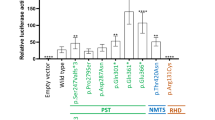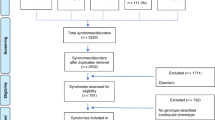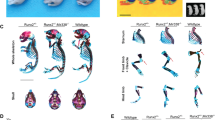Abstract
The combination of skull defects in the form of enlarged parietal foramina (PFM) and deficient ossification of the clavicles is known as parietal foramina with cleidocranial dysplasia (PFMCCD). It is considered to be distinct from classical cleidocranial dysplasia (CCD) and is listed as a separate OMIM entry (168550). So far, only two families have been reported and the molecular basis of the disorder is unknown. We present a third family with PFMCCD, comprising four affected individuals in three generations, and demonstrate that a heterozygous tetranucleotide duplication in the MSX2 homeobox gene (505_508dupATTG) segregates with the phenotype. PFMCCD is indeed aetiologically distinct from CCD, which is caused by mutations in the RUNX2 gene, but allelic with isolated PFM, in which MSX2 mutations were previously identified. Our observations highlight the role of MSX2 in clavicular development and the importance of radiological examination of the clavicles in subjects with PFM.
Similar content being viewed by others
Log in or create a free account to read this content
Gain free access to this article, as well as selected content from this journal and more on nature.com
or
References
Bartsch O, Wuyts W, Van Hul W et al: Delineation of a contiguous gene syndrome with multiple exostoses, enlarged parietal foramina, craniofacial dysostosis, and mental retardation, caused by deletions in the short arm of chromosome 11. Am J Hum Genet 1996; 58: 734–742.
Thompson EM, Baraitser M, Hayward RD : Parietal foramina in Saethre–Chotzen syndrome. J Med Genet 1984; 21: 369–372.
Wilkie AOM, Tang Z, Elanko N et al: Functional haploinsufficiency of the human homeobox gene MSX2 causes defects in skull ossification. Nat Genet 2000; 24: 387–390.
Wuyts W, Reardon W, Preis S et al: Identification of mutations in the MSX2 homeobox gene in families affected with foramina parietalia permagna. Hum Mol Genet 2000; 9: 1251–1255.
Wuyts W, Cleiren E, Homfray T et al: The ALX4 homeobox gene is mutated in patients with ossification defects of the skull (foramina parietalia permagna, OMIM 168500). J Med Genet 2000; 37: 916–920.
Mavrogiannis LA, Antonopoulou I, Baxova A et al: Haploinsufficiency of the human homeobox gene ALX4 causes skull ossification defects. Nat Genet 2001; 27: 17–18.
Mundlos S : Cleidocranial dysplasia: clinical and molecular genetics. J Med Genet 1999; 36: 177–182.
Otto F, Kanegane H, Mundlos S : Mutations in the RUNX2 gene in patients with cleidocranial dysplasia. Hum Mutat 2002; 19: 209–216.
Winter R, Baraitser M : London Dysmorphology Database. London: Oxford University Press, 2001.
Eckstein HB, Hoare RD : Congenital parietal foramina associated with faulty ossification of the clavicles. Br J Radiol 1963; 36: 220–221.
Hall BD : Syndromes and situations associated with congenital clavicular hypoplasia or agenesis. Prog Clin Biol Res 1982; 104: 279–288.
Golabi M, Carey J, Hall BD : Parietal foramina clavicular hypoplasia. An autosomal dominant syndrome. Am J Dis Child 1984; 138: 596–599.
Morriss-Kay GM : Derivation of the mammalian skull vault. J Anat 2001; 199: 143–151.
Hall BK : Development of the clavicles in birds and mammals. J Exp Zool 2001; 289: 153–161.
Huang LF, Fukai N, Selby PB, Olsen BR, Mundlos S : Mouse clavicular development: analysis of wild-type and cleidocranial dysplasia mutant mice. Dev Dyn 1997; 210: 33–40.
Satokata I, Ma L, Ohshima H et al: Msx2 deficiency in mice causes pleiotropic defects in bone growth and ectodermal organ formation. Nat Genet 2000; 24: 391–395.
Acknowledgements
We thank the family for their cooperation in this study, and Indira Taylor and Mike Oldridge for their help with the mutation and segregation analyses. This work was supported by the Alexander S Onassis Foundation and Medical Research Council (Studentships to LA Mavrogiannis), and by the Wellcome Trust (Senior Clinical Fellowship to AOM Wilkie).
Author information
Authors and Affiliations
Corresponding author
Rights and permissions
About this article
Cite this article
Garcia-Miñaur, S., Mavrogiannis, L., Rannan-Eliya, S. et al. Parietal foramina with cleidocranial dysplasia is caused by mutation in MSX2. Eur J Hum Genet 11, 892–895 (2003). https://doi.org/10.1038/sj.ejhg.5201062
Received:
Revised:
Published:
Issue date:
DOI: https://doi.org/10.1038/sj.ejhg.5201062
Keywords
This article is cited by
-
Dissection of mendelian predisposition and complex genetic architecture of craniovertebral junction malformation
Human Genetics (2023)
-
Palaeoneurological clues to the evolution of defining mammalian soft tissue traits
Scientific Reports (2016)
-
MSX2 mediates entry of human pluripotent stem cells into mesendoderm by simultaneously suppressing SOX2 and activating NODAL signaling
Cell Research (2015)
-
Domain duplication, divergence, and loss events in vertebrate Msx paralogs reveal phylogenomically informed disease markers
BMC Evolutionary Biology (2009)
-
Enlarged parietal foramina caused by mutations in the homeobox genes ALX4 and MSX2: from genotype to phenotype
European Journal of Human Genetics (2006)



